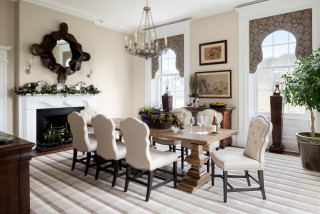
This article was originally published by a www.houzz.com . Read the Original article here. .
The Census estimate of new home sales posted an unexpected gain in April even as builders and consumers continue to deal with economic uncertainty, elevated interest rates and rising building material costs.
Sales of newly built, single-family homes in April increased 10.9% to a 743,000 seasonally adjusted annual rate from a downwardly revised March number, according to newly released data from the U.S. Department of Housing and Urban Development and the U.S. Census Bureau. The pace of new home sales in April was up 3.3% compared to a year earlier.
The April new home sales figure may be revised as it runs counter to market commentary and the fact that builder sentiment moved markedly lower in May. A less volatile look at the market would be the year-to-date figures, which show new home sales are down 1.2% thus far in 2025 on elevated interest rates, ongoing policy uncertainty and rising construction costs.
Rising inventory in the resale market is likely to place pressure on both pricing and sales activity for home builders during the second half of the year. The April new home data reflects this as new home inventory is leveling off near a half million of residences marketed for sale, up just 1.6% from January.
In April, new home inventory totaled 504,000 residences marketed for sale. While this is 8.6% higher than a year ago, it is only 1.6% higher from January. At the current sales pace, the months’ supply for new home stands at 8.1 compared to 7.7 a year ago.
To further illustrate the challenges builders are facing during the spring home buying season, 61% of home builders are using various kinds of sales incentives, including mortgage rate buydowns, to facilitate sales due to lackluster demand.
A new home sale occurs when a sales contract is signed, or a deposit is accepted. The home can be in any stage of construction: not yet started, under construction or completed. In addition to adjusting for seasonal effects, the April reading of 743,000 units is the number of homes that would sell if this pace continued for the next 12 months. This estimate may be revised lower next month.
Further, when accounting for existing, single-family home sales (a market which is showing rising inventory levels), total home inventory (new plus existing homes) is at a 4.8 months’ supply as of April. This is up from 4.6 from March and up from 4.1 from a year ago. The current reading is the highest since late 2015. Prior analysis indicates that the market will face notable inventory impacts on production as this measure approaches 5.5.
The median new home sale price in April was $407,200, compared to $415,300 a year ago.
Regionally, on a year-to-date basis, new home sales are down 32.5% in the Northeast, 14.8% in the Midwest and 2.4% in the West. Sales are up 5.7% in the South.
Discover more from Eye On Housing
Subscribe to get the latest posts sent to your email.
This article was originally published by a eyeonhousing.org . Read the Original article here. .
Builder confidence fell sharply in May on growing uncertainties stemming from elevated interest rates, tariff concerns, building material cost uncertainty and the cloudy economic outlook. However, 90% of the responses received in May were tabulated prior to the May 12 announcement that the United States and China agreed to slash tariffs for 90 days to allow trade talks to continue.
Builder confidence in the market for newly built single-family homes was 34 in May, down six points from April, according to the National Association of Home Builders (NAHB)/Wells Fargo Housing Market Index (HMI). This ties the November 2023 reading and is the lowest since the index hit 31 in December 2022.
The spring home buying season has gotten off to a slow start as persistent elevated interest rates, policy uncertainty and building material cost factors hurt builder sentiment in May. Builders expect future trade negotiations and progress on tax policy will help stabilize the economic outlook and strengthen housing demand. Initial trade arrangements with the United Kingdom and China are a welcome development for the macroeconomy. Still, the overall actions on tariffs in recent weeks have had a negative impact on builders, as 78% reported difficulties pricing their homes recently due to uncertainty around material prices.
The latest HMI survey also revealed that 34% of builders cut home prices in May, up from 29% in April and the highest level since December 2023 (36%). Meanwhile, the average price reduction was 5% in May, unchanged from the previous month. The use of sales incentives was 61% in May, the same rate as the previous month.
All three of the major HMI indices posted losses in May. The HMI index gauging current sales conditions fell eight points in May to a level of 37, the component measuring sales expectations in the next six months edged one-point lower to 42 while the gauge charting traffic of prospective buyers dropped two points to 23.
Derived from a monthly survey that NAHB has been conducting for more than 35 years, the NAHB/Wells Fargo HMI gauges builder perceptions of current single-family home sales and sales expectations for the next six months as “good,” “fair” or “poor.” The survey also asks builders to rate traffic of prospective buyers as “high to very high,” “average” or “low to very low.” Scores for each component are then used to calculate a seasonally adjusted index where any number over 50 indicates that more builders view conditions as good than poor.
Looking at the three-month moving averages for regional HMI scores, the Northeast fell three points to 44, the Midwest moved one point lower to 40, the South dropped two points to 37 and the West posted a two-point decline to 33.
The HMI tables can be found at nahb.org/hmi.
Discover more from Eye On Housing
Subscribe to get the latest posts sent to your email.
This article was originally published by a eyeonhousing.org . Read the Original article here. .
Growing economic uncertainty stemming from tariff concerns and elevated building material costs kept builder sentiment in negative territory in April, despite a modest bump in confidence likely due to a slight retreat in mortgage interest rates in recent weeks.
Builder confidence in the market for newly built single-family homes was 40 in April, edging up one point from March, according to the National Association of Home Builders (NAHB)/Wells Fargo Housing Market Index (HMI).
The March dip in mortgage rates may have stimulated some sales activity in recent weeks. However, builders have expressed growing uncertainty over market conditions as tariffs have increased price volatility for building materials at a time when the industry continues to grapple with labor shortages and a lack of buildable lots.
Policy uncertainty is making it difficult for builders to accurately price homes and make critical business decisions. The April HMI data indicates that the tariff cost effect is already taking hold, with the majority of builders reporting cost increases on building materials due to tariffs.
When asked about the impact of tariffs on their business, 60% of builders reported their suppliers have already increased or announced increases of material prices due to tariffs. On average, suppliers have increased their prices by 6.3% in response to announced, enacted, or expected tariffs. This means builders estimate a typical cost effect from recent tariff actions at $10,900 per home.
The latest HMI survey also revealed that 29% of builders cut home prices in April, unchanged from March. Meanwhile, the average price reduction was 5% in April, the same rate as the previous month. The use of sales incentives was 61% in April, up from 59% in March.
Derived from a monthly survey that NAHB has been conducting for more than 35 years, the NAHB/Wells Fargo HMI gauges builder perceptions of current single-family home sales and sales expectations for the next six months as “good,” “fair” or “poor.” The survey also asks builders to rate traffic of prospective buyers as “high to very high,” “average” or “low to very low.” Scores for each component are then used to calculate a seasonally adjusted index where any number over 50 indicates that more builders view conditions as good than poor.
The HMI index gauging current sales conditions rose two points in April to a level of 45. The gauge charting traffic of prospective buyers increased one point to 25 while the component measuring sales expectations in the next six months fell four points to 43.
Looking at the three-month moving averages for regional HMI scores, the Northeast fell seven points in April to 47, the Midwest moved one point lower to 41, the South dropped three points to 39 and the West posted a two-point decline to 35.
The HMI tables can be found at nahb.org/hmi.
Discover more from Eye On Housing
Subscribe to get the latest posts sent to your email.
This article was originally published by a eyeonhousing.org . Read the Original article here. .

Accept your strengths and weaknesses as a host. No one can do it all. The key to a low-stress event is to play up your strengths and outsource your not-so-favorite parts of entertaining. For instance, finish a homemade meal with a lovely dessert from a local bakery or throw a potluck buffet or cocktail party instead of having a formal sit-down meal.
Keep things real. Your guests are there to enjoy your company, not judge your home or your cooking. If you’re not “done” getting things ready before your guests arrive, ask for help. Most guests are more than happy to pitch in lighting candles, setting the table, stirring a pot or pouring wine. And before reading the checklist that follows, remember that you can always rent party gear rather than buy rarely used items.
This article was originally published by a www.houzz.com . Read the Original article here. .
Window boxes offer another opportunity to bring fall color up close. In this festive design by Garden Stories, a mix of brightly colored perennials, strappy grasses and interesting dried elements looks lovely from both inside and outside the house. Plants and dried ingredients include ‘Indian Summer’ rudbeckia (Rudbeckia hirta ‘Indian Summer’, zones 3 to 7), Japanese forest grass (Hakonechloa macra, zones 5 to 9), ‘Red Rooster’ leatherleaf sedge (Carex buchananii ‘Red Rooster’, zones 6 to 9), ‘Sombrero Hot Coral’ echinacea (Echinacea x hybrida ‘Sombrero Hot Coral’, zones 4 to 9), croton (Codiaeum variegatum, zones 9 to 12), sugar pine cones and miniature lotus pods.
Water requirement: Regular
Light requirement: Full sun